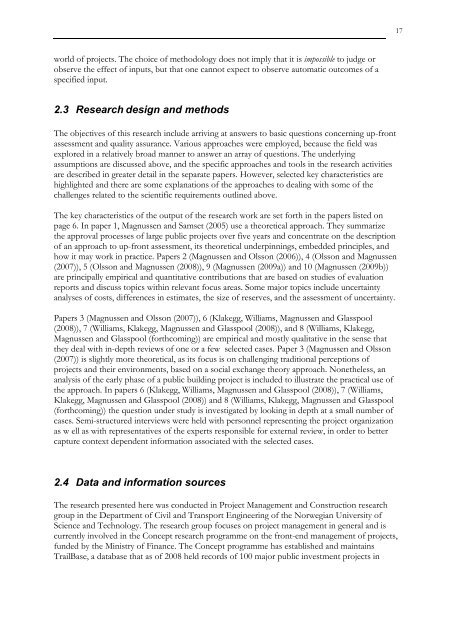Link to thesis. - Concept - NTNU
Link to thesis. - Concept - NTNU
Link to thesis. - Concept - NTNU
- No tags were found...
Create successful ePaper yourself
Turn your PDF publications into a flip-book with our unique Google optimized e-Paper software.
17world of projects. The choice of methodology does not imply that it is impossible <strong>to</strong> judge orobserve the effect of inputs, but that one cannot expect <strong>to</strong> observe au<strong>to</strong>matic outcomes of aspecified input.2.3 Research design and methodsThe objectives of this research include arriving at answers <strong>to</strong> basic questions concerning up-frontassessment and quality assurance. Various approaches were employed, because the field wasexplored in a relatively broad manner <strong>to</strong> answer an array of questions. The underlyingassumptions are discussed above, and the specific approaches and <strong>to</strong>ols in the research activitiesare described in greater detail in the separate papers. However, selected key characteristics arehighlighted and there are some explanations of the approaches <strong>to</strong> dealing with some of thechallenges related <strong>to</strong> the scientific requirements outlined above.The key characteristics of the output of the research work are set forth in the papers listed onpage 6. In paper 1, Magnussen and Samset (2005) use a theoretical approach. They summarizethe approval processes of large public projects over five years and concentrate on the descriptionof an approach <strong>to</strong> up-front assessment, its theoretical underpinnings, embedded principles, andhow it may work in practice. Papers 2 (Magnussen and Olsson (2006)), 4 (Olsson and Magnussen(2007)), 5 (Olsson and Magnussen (2008)), 9 (Magnussen (2009a)) and 10 (Magnussen (2009b))are principally empirical and quantitative contributions that are based on studies of evaluationreports and discuss <strong>to</strong>pics within relevant focus areas. Some major <strong>to</strong>pics include uncertaintyanalyses of costs, differences in estimates, the size of reserves, and the assessment of uncertainty.Papers 3 (Magnussen and Olsson (2007)), 6 (Klakegg, Williams, Magnussen and Glasspool(2008)), 7 (Williams, Klakegg, Magnussen and Glasspool (2008)), and 8 (Williams, Klakegg,Magnussen and Glasspool (forthcoming)) are empirical and mostly qualitative in the sense thatthey deal with in-depth reviews of one or a few selected cases. Paper 3 (Magnussen and Olsson(2007)) is slightly more theoretical, as its focus is on challenging traditional perceptions ofprojects and their environments, based on a social exchange theory approach. Nonetheless, ananalysis of the early phase of a public building project is included <strong>to</strong> illustrate the practical use ofthe approach. In papers 6 (Klakegg, Williams, Magnussen and Glasspool (2008)), 7 (Williams,Klakegg, Magnussen and Glasspool (2008)) and 8 (Williams, Klakegg, Magnussen and Glasspool(forthcoming)) the question under study is investigated by looking in depth at a small number ofcases. Semi-structured interviews were held with personnel representing the project organizationas w ell as with representatives of the experts responsible for external review, in order <strong>to</strong> bettercapture context dependent information associated with the selected cases.2.4 Data and information sourcesThe research presented here was conducted in Project Management and Construction researchgroup in the Department of Civil and Transport Engineering of the Norwegian University ofScience and Technology. The research group focuses on project management in general and iscurrently involved in the <strong>Concept</strong> research programme on the front-end management of projects,funded by the Ministry of Finance. The <strong>Concept</strong> programme has established and maintainsTrailBase, a database that as of 2008 held records of 100 major public investment projects in
















